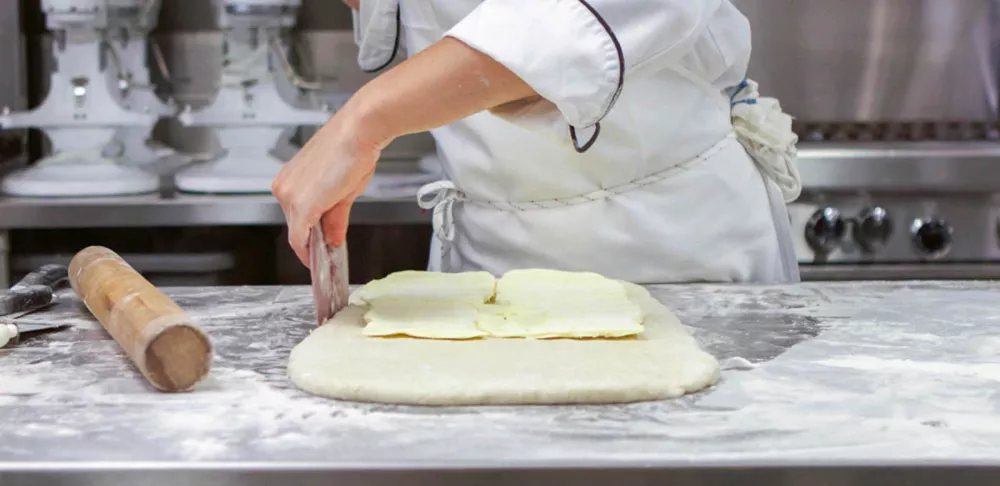I am constantly asking my students at ICE, “What role does this ingredient play in the recipe we are making?” In the case of butter—an ingredient most cooks take for granted—there are many answers. Most students immediately respond that butter adds flavor and richness to a recipe, which is correct. But did you know that butter could also be considered a leavening agent? (Think about puff pastry!) Let’s take a closer look at what—beyond flavor—butter is adding to all the fabulous baked goods ICE students are making in our classrooms.

Butter in Batters
Cake, muffin and other similar batters get mixed in one of two ways: the creaming method or the all-in-one method. The creaming method calls for beating room temperature butter and sugar together until it is light and fluffy. This mixing method creates air pockets in the butter and increases the volume of the batter. When eggs are incorporated, they add a significant amount of liquid to the batter and these air pockets fill with egg. As the ingredients are mixed, an emulsion of fat and water is created.
This emulsion is essential for creating stability in the dough. It allows for steam and carbon dioxide to be trapped in the batter as it is bakes, which causes your cake to rise. The butter also helps to create a light and tender texture in cake batter. In the all-in-one method, liquid butter and other liquid ingredients are mixed with dry ingredients in a single step. In this case, the butter is not whipped, but it serves to aerate the cake batter as the fat in the butter helps retain the gases released (steam and carbon dioxide) during baking. The liquefied butter also aids in creating a cake that is particularly moist.
Pie Crusts, Flaky Pastry and Biscuits
In biscuits, pie and pastry dough, butter is rubbed or cut into the flour. This causes the particles of flour to be coated in fat molecules, preventing excess liquid (like water or eggs) from absorbing into the flour, which creates an overdevelopment of gluten.
Have you ever heard of overworked pie dough being tough? That’s from the overdevelopment of gluten. The butter in the dough helps to create the light, flaky texture desired in these pastries. As the dough is baked, the butter melts and creates steam, trapping it in the dough and creating air pockets. Once the dough has cooled, these air pockets become delicate layers of flaky dough.
Viennoiserie
By this point, you’ve realized that butter adds more than flavor—it develops texture. When making croissants, butter and dough are folded into hundreds of individual layers. As a croissant bakes, the butter melts and the water content in the butter turns into steam. It’s that steam being trapped by the gluten in the dough that creates the delicate, flaky layers in a perfect croissant.
The fat in butter can also extend the shelf life of your baked goods. Consider a baguette and a loaf of brioche. The baguette contains absolutely no fat, so it goes stale and becomes dry within a day. Brioche, on the other hand, is loaded with butter and, in turn, will stay moist and soft for several days.
Choosing Your Butter
Now that we know what butter does, how does one choose the best butter for the task at hand? There are multiple factors to consider, but the most important is butterfat content. Butter is nothing more than an emulsion of butterfat, water and 1% or so of milk fat solids.
In the United States, there is a minimum federal standard of 80% butterfat content needed to label and sell a product as butter. Your average supermarket brands will go no further, squeaking in at 80% butterfat.
Butter labeled “European-style” generally has more butterfat, upwards of 83%. And artisanal butters—usually made by very small, local dairy farms—will produce butter with even higher amounts of butterfat, sometimes between 85% and 86%. One might immediately think the butter with the highest butterfat content is probably the best. It certainly is the most expensive!
But that’s not always the case. Sure, if you’re spreading butter on a slice of freshly baked bread, go for the extra rich 86% butter. It’s going to taste delicious. But for baking, your best bet is to use butter in the middle range of butterfat content.

Butter on the lower end of the spectrum (with the minimum 80% of butterfat) typically produces baked goods that are acceptable but not outstanding. Just a few extra percentage points of butterfat content can make a world of difference in flavor and texture.
On the other hand, butter with a very high butterfat percentage tends to cause cakes and bread to rise less and pastries to be less light and flaky. At ICE, our butter of choice is President. This European-style butter is made in Normandy—the crème de la crème of dairy-producing regions in France—has about 83% butterfat. It provides richness, but offers enough versatility for use across a wide range of baking techniques. Beyond butterfat, what makes President butter even better than other European-style brands is the addition of natural lactic ferments to the butter before churning.
This provides a subtle, tangy quality that enhances the butter’s natural flavor. When you’re considering your next baking endeavor, don’t skimp on the butter. It’s easy to overlook the ingredients we use most often, but they are the most worthy of special consideration. Just like flour, salt, milk or sugar, choosing a phenomenal butter transforms your pastries from merely good into something truly special.
Ready to master pastry production with Chef Jenny? Click here to learn more about ICE’s Pastry & Baking Arts program.




